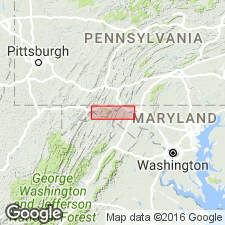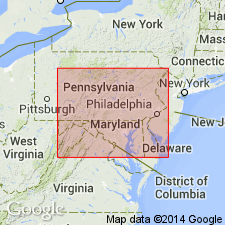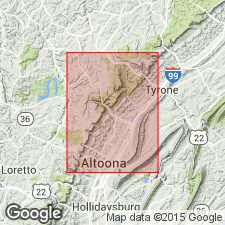
- Usage in publication:
-
- Rabble Run sandstone member
- Modifications:
-
- Named
- Dominant lithology:
-
- Sandstone
- Redbeds
- AAPG geologic province:
-
- Appalachian basin
Summary:
Rabble Run sandstone member of McKenzie formation (new name) is described as red strata lying about 100 ft below the top of the McKenzie in Washington Co., western MD. Eastward, they occur in Cacapon Mountain, west of Hancock, as thin tongues of red strata a few ft thick, separated by gray bands. Farther east, they increase in thickness until they finally merge to form one nearly continuous mass of red beds that attain a thickness of nearly 100 ft on Rabble Run in North Mountain. Closely resemble the younger Bloomsburg red sandstone. Age is Silurian.
Source: GNU records (USGS DDS-6; Reston GNULEX).

- Usage in publication:
-
- Rabble Run sandstone member
- Modifications:
-
- Areal extent
- AAPG geologic province:
-
- Appalachian basin
Summary:
McKenzie formation includes Rabble Run sandstone near its base in MD. Throughout southern PA and east-central MD, McKenzie has a red shale member near its top. This red unit, Rabble Run member, although 80 ft thick north of Potomac near Hancock Co., MD, thins rapidly southward and is represented in Morgan Co., WV, by only 5 ft of red sandy shale. It has no other important representative elsewhere in WV. It is believed that Rabble Run red bed thickens northeastward to coalesce with the eastern red, nonmarine facies (Bloomsburg) of the Cayugan group.
Source: GNU records (USGS DDS-6; Reston GNULEX).

- Usage in publication:
-
- Rabble Run Member
- Modifications:
-
- Revised
- AAPG geologic province:
-
- Appalachian basin
Summary:
Rabble Run Member assigned to Mifflintown Formation in PA. Age is Silurian.
Source: GNU records (USGS DDS-6; Reston GNULEX).

- Usage in publication:
-
- Rabble Run Member
- Modifications:
-
- Overview
- AAPG geologic province:
-
- Appalachian basin
Summary:
Approximately 30 m below the top of the Mifflintown, is a series of red beds termed the Rabble Run Member. The red shale is grayish red, calcareous, fossiliferous, and medium to thick bedded. The gray shale within the Member is medium gray, weathering to pale yellowish brown, noncalcareous, and very thin bedded. The Rabble Run Member is 40 m thick in an exposure along U.S. Rte 22 north of Point View in the Williamsburg quad. Above the Rabble Run is a sequence containing interbedded fossiliferous limestone and a subordinate amount of fossiliferous shale. Overlies the McKenzie Member, middle member of Mifflintown.
Source: GNU records (USGS DDS-6; Reston GNULEX).
For more information, please contact Nancy Stamm, Geologic Names Committee Secretary.
Asterisk (*) indicates published by U.S. Geological Survey authors.
"No current usage" (†) implies that a name has been abandoned or has fallen into disuse. Former usage and, if known, replacement name given in parentheses ( ).
Slash (/) indicates name conflicts with nomenclatural guidelines (CSN, 1933; ACSN, 1961, 1970; NACSN, 1983, 2005, 2021). May be explained within brackets ([ ]).

